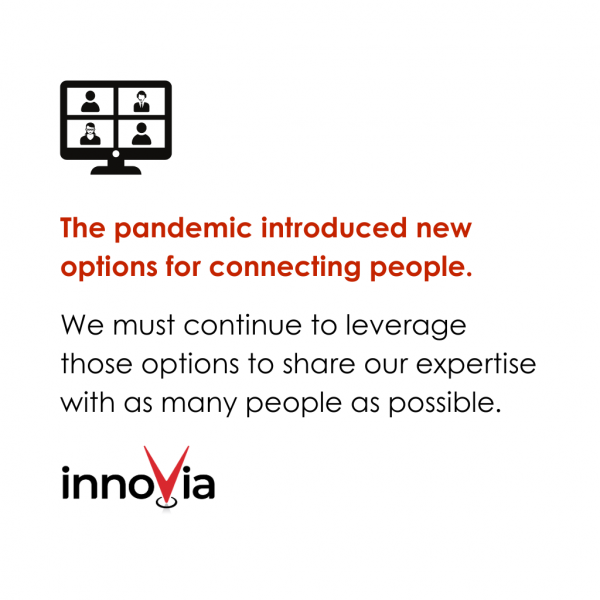It’s been four years since a global pandemic forced event stakeholders to retool their industry, and in-person events are again the norm.
Let me put the last five years into perspective. In 2019, less than 10 percent of innoVia’s events had a virtual component. If you were heading overseas for an investigator meeting and your flight was abruptly canceled, you’d likely be replaced as a presenter in a flash.
Then, in 2020, 100 percent of our events were completely virtual — a stark contrast from where we had been only a few months before. Now, about 98 percent of our events take place in person, and 80 percent of those events have a virtual component.
If that doesn’t illustrate our industry’s resourcefulness, I don’t know what will.
Like many of you, our clients and their attendees are happy to be back to face-to-face, or in-person, events. Given their interpersonal nature, in-person events can be more beneficial than purely online meetings and events.
However, those in-person events aren’t the same as they were pre-pandemic — nor should they be.
What We Learned From the Pandemic
In 2020, we had to learn how to navigate virtual meetings quickly. It was a period of rapid technological evolution, during which we flew the plane as we built it. Zoom hosted millions of daily meetings and ended the year with a record annual revenue of $2.6 billion — an unsurprising statistic.
Now, we’re seeing great compression in this space. Zoom and virtual platforms like it are no longer the primary event vehicles, but they still have a place in our industry. Some presenters and attendees even prefer the convenience of virtual meetings.
Here at innoVia Productions, we’re excited to leverage what we learned in the pandemic to offer flexible event options for our clients. Enter: hybrid events.

Terminology Time
Before we continue, let’s align our definitions:
- Virtual Event: 100 percent of the attendees and presenters meet on a virtual platform. The technology may be local to the presenters or in the cloud.
- In-Person Event: 100 percent of the attendees and presenters are on site at the event’s location. Pre-pandemic, the technology was local — attendees, technicians, and presenters would all travel to the event’s location.
Anything in between is a hybrid event.
About 80 percent of the events we produce have a hybrid component, up 800 percent from 2019, which isn’t surprising. Even though virtual-only events have some demonstrated downsides, they’re not without benefits. Hybrid events allow attendees to enjoy the best of both worlds.
For instance, the hybrid model allows for remote presenters and attendees, reducing travel and lodging expenses. Rather than paying a few thousand dollars to fly Dr. Smith to your next investigator meeting, he can join from his office, deliver his 30-minute presentation, and log off — no expenses required.
Hybrid events also allow attendees to use cloud-based interpretation technology, such as Remote Simultaneous Interpretation (RSI), where the meeting streams to interpreters, and they stream their interpretation back to the attendees.
RSI has improved our industry. It eliminates travel, hotel, and meal expenses for interpreters, eliminates interpretation booths (which saves money and frees up valuable space in the session rooms), and allows event stakeholders to hire interpreters anywhere in the world. Good luck finding an interpreter who speaks Japanese and understands microbiology in Austin — you’re much more likely to find one if you search the entire world.
Don’t have the resources to hire a human interpreter? No problem. Hybrid events allow for AI-based interpretation, which can interpret multiple languages simultaneously. If someone requests an Italian and a German interpreter the night before your sales meeting, AI-based interpretation will keep you from scrambling.
Cloud-based engagement tools are another benefit of hybrid events. Some of our favorites make Q&A and polling a breeze.
Why Are Hybrid Events Misunderstood?
Even after the coronavirus pandemic introduced us to the benefits of virtual components, hybrid events remain the black sheep of the live events industry.
Event stakeholders are often reluctant to use the term “hybrid” because of common misconceptions about blending in-person and virtual elements. Many believe hybrid events are too expensive, and others think interpreters must be on site, with no exceptions. Neither is true.
“Hybrid” doesn’t have a hard-and-fast definition. It can mean streaming an event to 20,000 attendees on multiple platforms using multi-camera production or streaming an event to 10 people on Zoom using a single camera.
There’s a wide range of options, and event organizers’ reticence to embrace the word “hybrid” prevents them from enjoying the benefits.
Are Virtual Events a Thing of the Past?
Only about two percent of the events innoVia produced last year were fully virtual. Our customers were happy to move away from remote meetings — they went into this industry expecting to be event planners, not virtual producers.
Most attendees, too, are happy to be back in person. Recent research confirms what event exhibitors already suspected: online meetings are less engaging for everyone involved.
Twenty-eight subjects recently participated in a study at Yale University that used eye-tracking, EEG brain wave measurement, and other tools to measure how attentively viewers watched in-person and online meetings. The conclusion: Participants who watched virtual meetings were more distracted.
Virtual events also limit networking opportunities, especially at sales meetings. It’s difficult to meet new people sitting in your office alone, even with 500,000 other virtual attendees.
So, are virtual-only events completely dead? We wouldn’t say so. They’re not without their benefits. For example, virtual-only events are much more cost-effective than in-person ones. Hosting a 5,000-person virtual event with 10 breakouts costs less than an in-person event’s food and beverage expenses alone.
Walk into an office and ask, “Should we produce our event virtually?” If money is no object, you’ll get a different answer depending on who you speak to. Salespeople, whose careers hinge on networking opportunities, will protest. But medical doctors, who often can’t get out of town for the weekend, would prefer to fire up their computers for an hour or two and then return to treating their patient panel.
Virtual events are just another tool in your tool belt. For some event stakeholders, they’re just not the right tool — and that’s okay.

Final Thoughts
The benefits of face-to-face meetings are clear, but not every event stakeholder is keen on giving up their weekend to fly or drive out of town. The pandemic introduced new options for connecting people. We must continue to leverage those options to share our expertise with as many people as possible.
In-person events with virtual components — the hybrid model — have clear advantages, and 80 percent of our clients benefit from that option. If you’re an event stakeholder, we want to help you better communicate hybrid events’ value to your clients.
We’re happy to have that conversation with you. Get in touch today.






